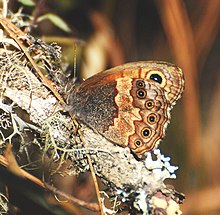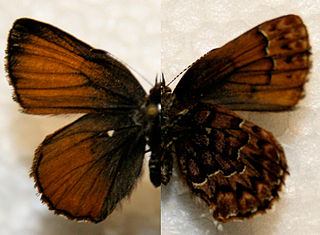
The western pine elfin is a North American butterfly that ranges from British Columbia east to Maine and south to southern California, Arizona, and New Mexico. Males are brown and females are orange-brown, with both having bold patterned hind wings. The top of the wings have dark bars with a lighter chevron shaped margin. The body is 19–32 mm in length and has no tail.

Polygonia is a genus of butterflies with a conspicuous white mark on the underside of each hindwing, hence the common name comma. They also have conspicuous angular notches on the outer edges of their forewings, hence the other common name anglewing butterflies. The related genus Nymphalis also includes some anglewing species; Polygonia is sometimes classified as a subgenus of Nymphalis.

The Huachuca Mountains are part of the Sierra Vista Ranger District of the Coronado National Forest in Cochise County in southeastern Arizona, approximately 70 miles (110 km) south-southeast of Tucson and southwest of the city of Sierra Vista. Included in this area is the highest peak in the Huachucas, Miller Peak, and the region of the Huachucas known as Canelo Hills in eastern Santa Cruz County. The mountains range in elevation from 3,934 feet (1,199 m) at the base to 9,466 feet (2,885 m) at the top of Miller Peak. The second highest peak in this range is Carr Peak, elevation 9,200 feet (2,804 m). The Huachuca Mountain area is managed principally by the United States Forest Service (41%) and the U.S. Army (20%), with much of the rest being private land (32%). Sierra Vista is the main population center.

Asclepias linaria is a species of milkweed known by the common name pineneedle milkweed.

Telegonus cellus, the golden banded-skipper, is a North and Central American species of butterfly in the family Hesperiidae. There are two populations, one in the eastern United States and the other in the southwestern United States and Mexico. The eastern population is rare and local and uses only one host plant, the thicket bean. The southwestern population is uncommon to common and uses more than one host plant. The golden banded-skipper is most active mid-morning and late afternoon. Their flight is sluggish and low to the ground, compared to closely related species.

Megisto is a genus of butterflies of the subfamily Satyrinae in the family Nymphalidae.

Ridens is a genus of Neotropical butterflies in the family Hesperiidae (Eudaminae).

Neophasia terlooii, the Chiricahua white,Chiricahua pine white, or Mexican pine white is a butterfly in the family Pieridae. It is found in New Mexico, in the high mountains of Arizona, and south into Mexico. The habitat consists of forests of needled conifers - Family Pinaceae.
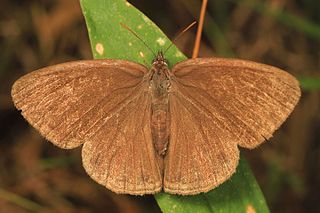
Hermeuptychia sosybius, the Carolina satyr, is a butterfly of the family Nymphalidae. It is found in the United States from southern New Jersey south along the coast to southern Florida, west to south-eastern Kansas, central Oklahoma and central Texas. It is also found in Mexico and Central America.

Euphilotes battoides, the square-spotted blue or buckwheat blue, is a species of butterfly of the family Lycaenidae.
Paramacera is a genus of satyrid butterflies found in the Nearctic and Neotropical realms.
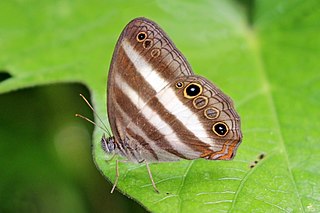
Pareuptychia ocirrhoe, the two-banded satyr or banded white ringlet, is a species of butterfly of the family Nymphalidae. It is found from Mexico to the Guyanas, Paraguay and northern Argentina. The habitat consists of forests.
Leona allyni is a butterfly in the family Hesperiidae. It is found in the Democratic Republic of the Congo.
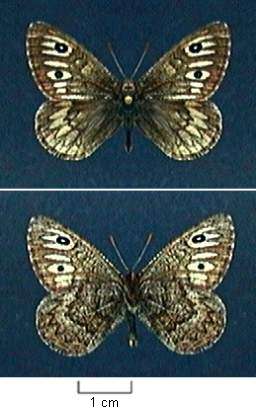
Neominois ridingsii, or Ridings' satyr, is a species of butterfly in the family Nymphalidae. It is found from southern Alberta, Saskatchewan and Manitoba south to the Guadalupe and Catron counties of New Mexico, and west to the central Sierra Nevada of California and central Oregon. The habitat consists of short-grass prairie, intermountain areas and grasslands with some areas of bare soil.
Neominois carmen, the Joboni satyr, is a species of butterfly in the family Nymphalidae. It is found in north-eastern Mexico, at least from the Maderas del Carmen in north-western Coahuila, to the area west of Linares in southern Nuevo León. The habitat consists of open areas at the beginning of pine-oak woodland.

The forests of Mexico cover a surface area of about 64 million hectares, or 34.5% of the country. These forests are categorized by the type of tree and biome: tropical forests, temperate forests, cloud forests, riparian forests, deciduous, evergreen, dry, moist, etc.. The agency in charge of Mexico's forests is the National Forestry Commission. Despite major reforms to the Constitution in 1992 regarding private land, Mexico enacted major forest regulation laws in 1998 and 2003. Though no longer required to enforce land regulation in Mexico, Article 27 of the Constitution also still permits the Government to enact land regulation.

Cyllopsis pyracmon, or Nabokov's satyr, is a species of alpine, arctic, nymph, or satyr in the family Nymphalidae. It is found in North America.

Euphilotes bernardino, the Bernardino blue, is a butterfly in the family Lycaenidae. The species was first described by William Barnes and James Halliday McDunnough in 1916. It is found in North America.
